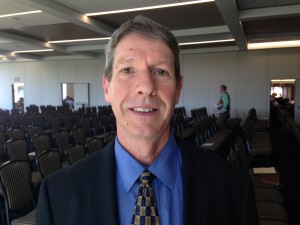EPA Team Looking At Relationship Between Irving Quakes and Disposal Well

Photo by Philip Issa
Philip Dellinger is head of the EPA’s Underground Injection Control Section for Region 6 in Dallas.
The earthquakes that have shaken Dallas and Irving, Texas the last several months have people looking into whether oil and gas activity in the area plays a role. Some of those people work at the Environmental Protection Agency. But EPA researchers say they’re not getting the data they’ve requested from Texas state oil and gas regulators to investigate the possible link.
Philip Dellinger is head of the EPA’s Underground Injection Control Section in Dallas. At a conference of the Groundwater Protection Council Tuesday, he showed early results from a study his team conducted on earthquakes around Irving.
The group looked at the use of wastewater disposal wells closest to Irving earthquakes. Dellinger does not necessarily believe the recent quakes are related to disposal wells, where wastewater from oil and gas drilling is pumped underground. But these types of wells have caused other earthquakes, so his team wanted to see what wells were close to the Irving events.
His choice for where to look was simple. There are only two wells near the recent quakes, and one had been plugged up.
Even the active well is “a good distance off,” says Dellinger, “it’s ten or eleven miles away from the [earthquake] activity.”
Using an approach outlined in the EPA’s new report on manmade earthquakes, the team used data on the volume of fluid being injected into the wells and the rate of injection. It looked at how that might impact the underground region where the wastewater was flowing. It compared that data to earthquakes going years back.
“It showed some correspondence with some of the early earthquakes, but some of those early earthquakes were many miles away from the recent Irving earthquakes,” Dellinger says.
Those quakes were also thought to be associated with the disposal well that is now plugged up.
“The recent earthquakes are clustered in a localized area and they were very frequent.” he says.
So the EPA team requested daily injection data for the disposal well that is still in operation. The request was made to state oil and gas regulators, The Railroad Commission of Texas, in January, after quakes above 3.0 began shaking the Dallas region.
Dellinger says the Railroad Commission has not yet shared any data. When asked if he knew why the commission had not passed the data along, he said, “No.”
In a statement provided to StateImpact Texas, the Railroad Commission said that their staff seismologist, Dr. Craig Pearson, “has not found it necessary to request additional information beyond what is required by Railroad Commission rules from the closest disposal well.”
The EPA’s Dellinger appears confident the commission could share the data if it wanted to.
“After the last few years of seeing this [earthquake activity] here in the South Central part of the country, these regulators are looking at disposal wells,” says Dellinger. “You just don’t hear it on the news.”


